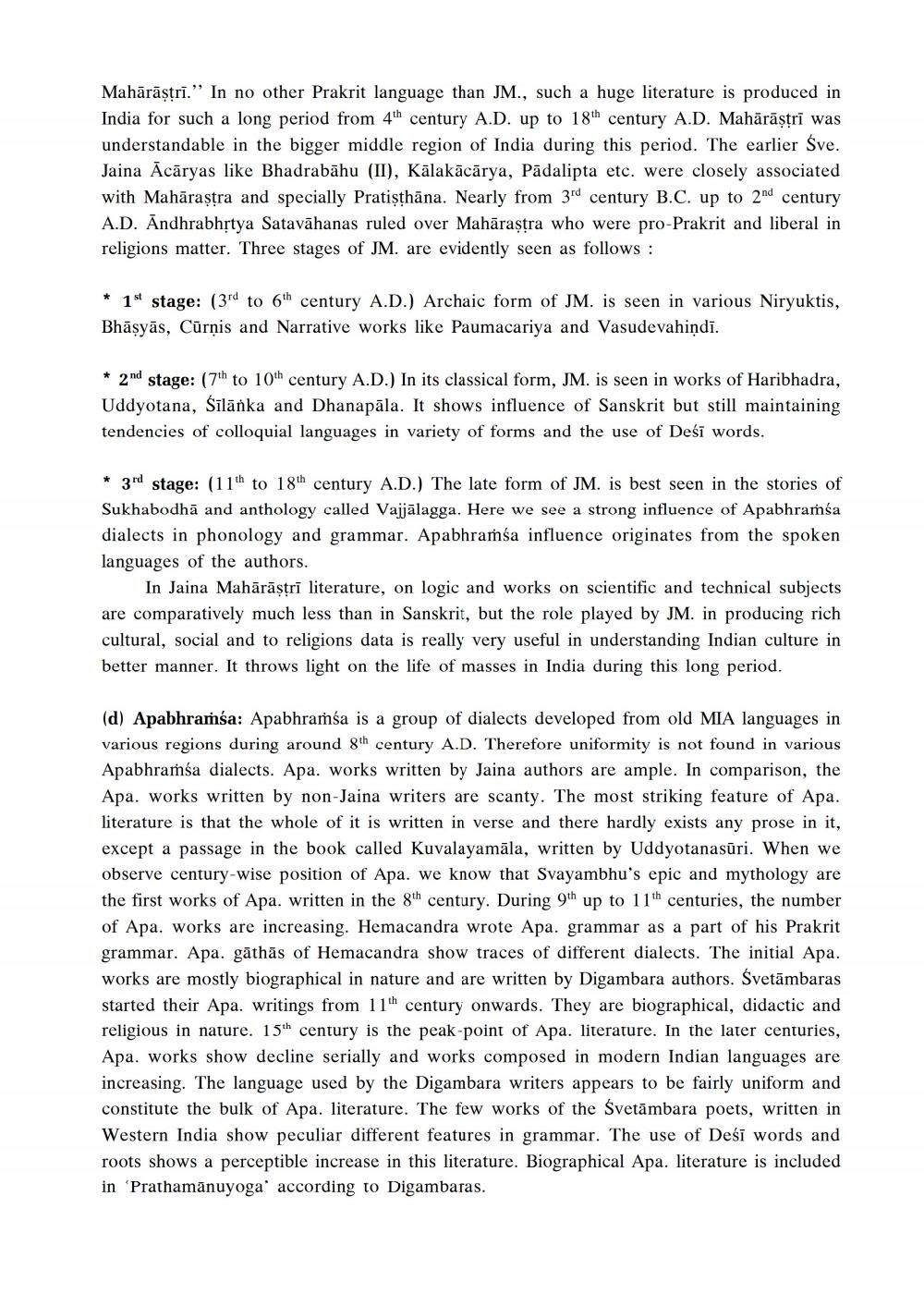________________
Mahārāștrī." In no other Prakrit language than JM., such a huge literature is produced in India for such a long period from 4th century A.D. up to 18th century A.D. Mahārāștri was understandable in the bigger middle region of India during this period. The earlier Śve. Jaina Ācāryas like Bhadrabāhu (II), Kālakācārya, Pādalipta etc. were closely associated with Mahārastra and specially Pratisthāna. Nearly from 3rd century B.C. up to 2nd century A.D. Andhrabhstya Satavāhanas ruled over Mahārastra who were pro-Prakrit and liberal in religions matter. Three stages of JM. are evidently seen as follows:
* 1st stage: (3rd to 6th century A.D.) Archaic form of JM. is seen in various Niryuktis, Bhāṇyās, Cūrņis and Narrative works like Paumacariya and Vasudevahindi.
* 2nd stage: (7th to 10th century A.D.) In its classical form, JM. is seen in works of Haribhadra, Uddyotana, Sīlānka and Dhanapāla. It shows influence of Sanskrit but still maintaining tendencies of colloquial languages in variety of forms and the use of Deśī words.
* 3rd stage: (11th to 18th century A.D.) The late form of JM. is best seen in the stories of Sukhabodhā and anthology called Vajjālagga. Here we see a strong influence of Apabhraíía dialects in phonology and grammar. Apabhramśa influence originates from the spoken languages of the authors.
In Jaina Mahārāștri literature, on logic and works on scientific and technical subjects are comparatively much less than in Sanskrit, but the role played by JM. in producing rich cultural, social and to religions data is really very useful in understanding Indian culture in better manner. It throws light on the life of masses in India during this long period.
(d) Apabhramśa: Apabhramśa is a group of dialects developed from old MIA languages in various regions during around 8th century A.D. Therefore uniformity is not found in various Apabhraṁsa dialects. Apa. works written by Jaina authors are ample. In comparison, the Apa. works written by non-Jaina writers are scanty. The most striking feature of Apa. literature is that the whole of it is written in verse and there hardly exists any prose in it, except a passage in the book called Kuvalayamāla, written by Uddyotanasūri. When we observe century-wise position of Apa. we know that Svayambhu's epic and mythology are the first works of Apa. written in the 8th century. During 9th up to 11th centuries, the number of Apa. works are increasing. Hemacandra wrote Apa. grammar as a part of his Prakrit grammar. Apa. gāthās of Hemacandra show traces of different dialects. The initial Apa. works are mostly biographical in nature and are written by Digambara authors. Svetāmbaras started their Apa. writings from 11th century onwards. They are biographical, didactic and religious in nature. 15th century is the peak-point of Apa. literature. In the later centuries, Apa. works show decline serially and works composed in modern Indian languages are increasing. The language used by the Digambara writers appears to be fairly uniform and constitute the bulk of Apa. literature. The few works of the Svetāmbara poets, written in Western India show peculiar different features in grammar. The use of Deśī words and roots shows a perceptible increase in this literature. Biographical Apa. literature is included in 'Prathamānuyoga' according to Digambaras.




